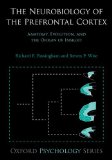July 1, 2014

The Neurobiology of the Prefrontal Cortex: Anatomy, Evolution, and the Origin of Insight (Oxford Psychology Series) by Richard E. Passingham and Steven P. Wise (Oxford University Press, 2014)
(kindle ed.), (amazon.co.uk), (UK kindle ed.)
Book description from the publisher:
The prefrontal cortex makes up almost a quarter of the human brain, and it expanded dramatically during primate evolution. The Neurobiology of the Prefrontal Cortex presents a new theory about its fundamental function. In this important new book, the authors argue that primate-specific parts of the prefrontal cortex evolved to reduce errors in foraging choices, so that particular ancestors of modern humans could overcome periodic food shortages. These developments laid the foundation for working out problems in our imagination, which resulted in the insights that allow humans to avoid errors entirely, at least at times.
In the book, the authors detail which parts of the prefrontal cortex evolved exclusively in primates, how its connections explain why the prefrontal cortex alone can perform its function, and why other parts of the brain cannot do what the prefrontal cortex does. Based on an analysis of its evolutionary history, the book uses evidence from lesion, imaging, and cell-recording experiments to argue that the primate prefrontal cortex generates goals from a current behavioural context and that it can do so on the basis of single events. As a result, the prefrontal cortex uses the attentive control of behaviour to augment an older general-purpose learning system, one that evolved very early in the history of animals. This older system learns slowly and cumulatively over many experiences based on reinforcement. The authors argue that a new learning system evolved in primates at a particular time and place in their history, that it did so to decrease the errors inherent in the older learning system, and that severe volatility of food resources provided the driving force for these developments.
Written by two leading brain scientists, The Neurobiology of the Prefrontal Cortex is an important contribution to our understanding of the evolution and functioning of the human brain.
Google Books preview:
See also: R. Passingham’s webpage
Comments (0)
- cognitive science,human evolution,new books
April 21, 2014

Origins of Language: A Slim Guide by James R. Hurford (Oxford University Press, USA, 2014)
(kindle ed.), (amazon.co.uk), (UK kindle ed.)
Book description from the publisher:
Origins of Language: A Slim Guide offers a concise and accessible overview of what is known about the evolution of the human capacity for language. Non-human animals communicate in simple ways: they may be able to form simple concepts, to feel some limited empathy for others, to cooperate to some extent, and to engage in mind-reading. Human language, however, is characterized by its ability to efficiently express a wide range of subtle and complex meanings. After the first simple beginnings, human language underwent an explosion of complexity, leading to the very complicated systems of grammar and pronunciation found in modern languages.
Jim Hurford looks at the very varied aspects of this evolution, covering human prehistory; the relation between instinct and learning; biology and culture; trust, altruism, and cooperation; animal thought; human and non-human vocal anatomy; the meanings and forms of the first words; and the growth of complex systems of grammar and pronunciation. Written by an internationally recognized expert in the field, it draws on a number of disciplines besides linguistics, including philosophy, neuroscience, genetics, and animal behaviour, and will appeal to a wide range of readers interested in language origins and evolution.
Google Books preview:
See also: Author’s homepage
Comments (0)
- human evolution,language,new books
April 16, 2014

The Punisher’s Brain: The Evolution of Judge and Jury by Morris B. Hoffman (Cambridge University Press, 2014)
(amazon.co.uk)
Book description from the publisher:
Why do we punish, and why do we forgive? Are these learned behaviors, or is there something deeper going on? This book argues that there is indeed something deeper going on, and that our essential response to the killers, rapists, and other wrongdoers among us has been programmed into our brains by evolution. Using evidence and arguments from neuroscience and evolutionary psychology, Morris B. Hoffman traces the development of our innate drives to punish – and to forgive – throughout human history. He describes how, over time, these innate drives became codified into our present legal systems and how the responsibility and authority to punish and forgive was delegated to one person – the judge – or a subset of the group – the jury. Hoffman shows how these urges inform our most deeply held legal principles and how they might animate some legal reforms.
See also: Author’s webpage
Comments (0)
- human evolution,psychology
April 14, 2014

Snakes, Sunrises, and Shakespeare: How Evolution Shapes Our Loves and Fears by Gordon H. Orians (University of Chicago Press, 2014)
(kindle ed.), (amazon.co.uk), (UK kindle ed.)
Book description from the publisher:
Our breath catches and we jump in fear at the sight of a snake. We pause and marvel at the sublime beauty of a sunrise. These reactions are no accident; in fact, many of our human responses to nature are steeped in our deep evolutionary past—we fear snakes because of the danger of venom or constriction, and we welcome the assurances of the sunrise as the predatory dangers of the dark night disappear. Many of our aesthetic preferences—from the kinds of gardens we build to the foods we enjoy and the entertainment we seek—are the lingering result of natural selection.
In this ambitious and unusual work, evolutionary biologist Gordon H. Orians explores the role of evolution in human responses to the environment, beginning with why we have emotions and ending with evolutionary approaches to aesthetics. Orians reveals how our emotional lives today are shaped by decisions our ancestors made centuries ago on African savannas as they selected places to live, sought food and safety, and socialized in small hunter-gatherer groups. During this time our likes and dislikes became wired in our brains, as the appropriate responses to the environment meant the difference between survival or death. His rich analysis explains why we mimic the tropical savannas of our ancestors in our parks and gardens, why we are simultaneously attracted to danger and approach it cautiously, and how paying close attention to nature’s sounds has resulted in us being an unusually musical species. We also learn why we have developed discriminating palates for wine, and why we have strong reactions to some odors, and why we enjoy classifying almost everything.
By applying biological perspectives ranging from Darwin to current neuroscience to analyses of our aesthetic preferences for landscapes, sounds, smells, plants, and animals, Snakes, Sunrises, and Shakespeare transforms how we view our experience of the natural world and how we relate to each other.
Google Books preview:
Comments (0)
- human evolution,new books,psychology
February 3, 2014

A Natural History of Human Thinking by Michael Tomasello (Harvard University Press, 2013)
(kindle ed.), (amazon.co.uk), (UK kindle ed.)
Book description from the publisher:
Tool-making or culture, language or religious belief: ever since Darwin, thinkers have struggled to identify what fundamentally differentiates human beings from other animals. In this much-anticipated book, Michael Tomasello weaves his twenty years of comparative studies of humans and great apes into a compelling argument that cooperative social interaction is the key to our cognitive uniqueness. Once our ancestors learned to put their heads together with others to pursue shared goals, humankind was on an evolutionary path all its own.
Tomasello argues that our prehuman ancestors, like today’s great apes, were social beings who could solve problems by thinking. But they were almost entirely competitive, aiming only at their individual goals. As ecological changes forced them into more cooperative living arrangements, early humans had to coordinate their actions and communicate their thoughts with collaborative partners. Tomasello’s “shared intentionality hypothesis” captures how these more socially complex forms of life led to more conceptually complex forms of thinking. In order to survive, humans had to learn to see the world from multiple social perspectives, to draw socially recursive inferences, and to monitor their own thinking via the normative standards of the group. Even language and culture arose from the preexisting need to work together. What differentiates us most from other great apes, Tomasello proposes, are the new forms of thinking engendered by our new forms of collaborative and communicative interaction.
A Natural History of Human Thinking is the most detailed scientific analysis to date of the connection between human sociality and cognition.
Google Books preview:
See also: Author’s webpage
Comments (0)
- culture,human evolution,new books







